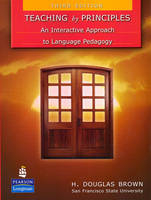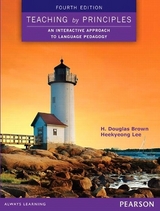
Teaching by Principles: An Interactive Approach to Language Pedagogy
Pearson Education (US) (Verlag)
978-0-13-612711-6 (ISBN)
- Titel erscheint in neuer Auflage
- Artikel merken
new chapters on course design, technology and critical pedagogy to reflect current trends and advances in methodology
prereading organizers at the beginning of each chapter
updated, expanded references
treatment of other recent "hot topics" of interest:
corpus linguistics
form-focused instruction
multiple intelligences
nonnative English-speaking teachers
autonomy
willingness to communicate
alternatives in assessment
reflective teaching
Also by H. Douglas Brown:
Principles of Language Learning and Teaching, Fifth Edition
Language Assessment: Principles and Classroom Practices
Strategies for Success: A PRactical Guide to Learning English
Dr. H. Douglas Brown, a professor in the MA-TESOL program at San Francisco State University, has written many articles, teacher training books, and textbooks on language pedagogy. A past president of TESOL and recipient of the James A. Alatis Award for Distinguished Service, Dr. Brown has lectured to English language teaching audiences around the world.
PART I. FOUNDATIONS FOR CLASSROOM PRACTICE
Chapter 1 Getting Started
A Classroom Observation
Beneath the Lesson
Topics for Discussion, Action, and Research
For Your Further Reading
Chapter 2 A "Methodical" History of Language Teaching
Approach, Method, and Technique
Changing Winds and Shifting Sands
The Grammar Translation Method
Gouin and the Series Method
The Direct Method
The Audiolingual Method
Cognitive Code Learning
“Designer” Methods of the Spirited 1970s
Community Language Learning
Suggestopedia
The Silent Way
Total Physical Response
The Natural Approach
Functional Syllabuses
Topics for Discussion, Action, and Research
For Your Further Reading
Chapter 3 The Post-Method Era: Toward Informed Approaches
The Dysfunction of the Theory-Practice Dichotomy
An Enlightened, Eclectic Approach
Communicative Language Teaching
Task-Based Language Teaching
Learner-Centered Instruction
Cooperative Learning
Interactive Learning
Whole Language Education
Content-Based Instruction
Other Candidates for CLT Approaches
Topics for Discussion, Action, and Research
For Your Further Reading
Chapter 4 Teaching by Principles
Cognitive Principles
Automaticity
Meaningful Learning
The Anticipation of Reward
Intrinsic Motivation
Strategic Investment
Autonomy
Socioaffective Principles
Language Ego
Willingness to Communicate
The Language-Culture Connection
Linguistic Principles
The Native Language Effect
Interlanguage
Communicative Competence
Topics for Discussion, Action, and Research
For Your Further Reading
Chapter 5 Intrinsic Motivation in the Classroom
Defining Motivation
A Behavioral Definition
Cognitive Definitions
Intrinsic and Extrinsic Motivation
Intrinsic Motivation in Education
Intrinsic Motivation in the Second Language Classroom
Topics for Discussion, Action, and Research
For Your Further Reading
PART II. CONTEXTS OF LEARNING AND TEACHING
Chapter 6 Teaching Across Age Levels
Teaching Children
Intellectual Development
Attention Span
Sensory Input
Affective Factors
Authentic, Meaningful Language
Teaching Adults
Teaching Teens
Topics for Discussion, Action, and Research
For Your Further Reading
Chapter 7 Teaching Across Proficiency Levels
Defining Proficiency Levels
Teaching Beginning Levels
Teaching Intermediate Levels
Teaching Advanced Levels
Topics for Discussion, Action, and Research
For Your Further Reading
Chapter 8 Sociocultural, Political, and Institutional Contexts
Cultural Contexts
Second and Foreign Language Contexts
English as an International Language
Non-native English-speaking Teachers
Language Policy Issues
Institutional Contexts
Elementary and Secondary Schools
Post-Secondary and Adult Education
Topics for Discussion, Action, and Research
For Your Further Reading
PART III. DESIGNING AND IMPLEMENTING CLASSROOM LESSONS
Chapter 9 Curriculum Design
An Overview of the Curriculum Design Process
Situation Analysis
Needs Analysis
Problematizing
Specifying Goals
Conceptualizing a Course Syllabus
Selecting Textbooks, Materials, and Resources
Assessment
Program Evaluation
Topics for Discussion, Action, and Research
For Your Further Reading
Chapter 10 Lesson Planning
Format of a Lesson Plan
Guidelines for Lesson Planning
Sample Lesson Plan
Topics for Discussion, Action, and Research
For Your Further Reading
Chapter 11 Techniques and Materials
Techniques Redefined
Categorizing Techniques: A Bit of History
A Taxonomy of Techniques
Textbooks
Other Texts and Visual Aids
Topics for Discussion, Action, and Research
For Your Further Reading
Chapter 12 Technology in the Classroom
Non-Computer-Based Technology
Computer Assisted Language Learning (CALL)
CALL, CMC, TMLL, or What?
Principles and Benefits of CALL
Uses of CALL in the Language Classroom
Topics for Discussion, Action, and Research
Some Useful Web Resources
For Your Further Reading
Chapter 13 Initiating Interaction in the Classroom
What is Interaction?
Interactive Principles
Roles of the Interactive Teacher
Foreign Language Interaction Analysis
Questioning Strategies for Interactive Learning
Topics for Discussion, Action, and Research
For Your Further Reading
Chapter 14 Sustaining Interaction through Group Work
Advantages of Group Work
Excuses for Avoiding Group Work
Implementing Group Work in Your Classroom
Classroom Language
Selecting Appropriate Group Techniques
Planning Group Work
Monitoring the Task
Debriefing
Topics for Discussion, Action, and Research
For Your Further Reading
Chapter 15 Classroom Management
The Physical Environment of the Classroom
Your Voice and Body Language
Unplanned Teaching: Midstream Lesson Changes
Teaching Under Adverse Circumstances
Teachers’ Roles and Styles
Creating a Positive Classroom Climate
Topics for Discussion, Action, and Research
For Your Further Reading
Chapter 16 Strategies-Based Instruction
Strategic Investment
Good Language Learners
Styles of Successful Language Learning
Awareness and Action
Developing Student Self-awareness of Styles
How to Teach Strategies in the Classroom
“Packaged” Models of SBI
Topics for Discussion, Action, and Research
For Your Further Reading
PART IV. TEACHING LANGUAGE SKILLS
Chapter 17 Integrating the Four Skills
Why Integrated Skills?
Models of Skills Integration
Content-Based Instruction
Task-Based Language Teaching
Theme-Based Instruction
Experiential Learning
The Episode Hypothesis
An Integrated Lesson
Topics for Discussion, Action, and Research
For Your Further Reading
Chapter 18 Teaching Listening
Listening Comprehension in Pedagogical Research
An Interactive Model of Listening Comprehension
Types of Spoken Language
What Makes Listening Difficult?
Microskills and Macroskills of Listening
Types of Classroom Listening Performance
Principles for Teaching Listening Skills
Listening Techniques from Beginning to Advanced
Assessing Listening in the Classroom
On Understanding the terms Assessment and Test
Assessing Types of Listening and Micro- and Macroskills
Topics for Discussion, Action, and Research
For Your Further Reading
Chapter 19 Teaching Speaking
Oral Communication Skills in Pedagogical Research
Types of Spoken Language
What Makes Speaking Difficult?
Micro- and Macroskills of Oral Communication
Types of Classroom Speaking Performance
Principles for Teaching Speaking Skills
Teaching Conversation
Teaching Pronunciation
Focus on Form and Error Treatment
Assessing Speaking in the Classroom
Item Types and Tasks for Assessing Speaking
Topics for Discussion, Action, and Research
For Your Further Reading
Chapter 20 Teaching Reading
Research on Reading a Second Language
Genres of Written Language
Characteristics of Written Language
Micro- and Macroskills for Reading Comprehension
Strategies for Reading Comprehension
Types of Classroom Reading Performance
Principles for Teaching Reading Skills
Two Reading Lessons
Assessing Reading
Topics for Discussion, Action, and Research
For Your Further Reading
Chapter 21 Teaching Writing
Research on Second Language Writing
Types of Written Language
Characteristics of Written Language: A Writer’s View
Micro- and Macroskills for Writing
Types of Classroom Writing Performance
Principles for Teaching Writing Skills
Assessing Writing
Evaluation Checklists
Writing Assessment Tasks
Topics for Discussion, Action, and Research
For Your Further Reading
Chapter 22 Form-Focused Instruction
The Place of Grammar
To Teach or Not to Teach Grammar
Issues About How to Teach Grammar
Grammar Techniques
Grammar Sequencing in Textbooks and Curricula
Current Issues in Vocabulary Teaching
Principles for Teaching Vocabulary
Topics for Discussion, Action, and Research
For Your Further Reading
PART V. ASSESSING LANGUAGE SKILLS
Chapter 23 Language Assessment: Principles and Issues
Testing, Assessing, and Teaching
Principles of Language Assessment
Practicality
Reliability
Validity
Content Validity
Face Validity
Construct Validity
Authenticity
Washback
Kinds of Tests
Historical Developments in Language Assessment
Current Issues in Language Assessment
Topics for Discussion, Action, and Research
For Your Further Reading
Chapter 24 Classroom-Based Assessment
Norm-Referenced and Criterion-Referenced Tests
Some Practical Steps to Test Construction
Turning Existing Tests into more Effective Procedures
Alternatives in Assessment
Scrutinizing the Alternatives
Topics for Discussion, Action, and Research
For Your Further Reading
PART VI. LIFELONG LEARNING
Chapter 25 Teacher Development
Peak Performers
The “Good” Language Teacher
Classroom Observation
Classroom-Based “Action” Research
Teacher Collaboration: Learning from each other
Journals, Teaching Portfolios, Reading, and Writing
Topics for Discussion, Action, and Research
For Your Further Reading
Chapter 26 Teachers for Social Responsibility
Critical Pedagogy
Hot Topics in the Language Classroom
Moral Dilemmas and Moral Imperatives
Agents for Change
Topics for Discussion, Action, and Research
For Your Further Reading
Bibliography
Name Index
Subject Index
| Erscheint lt. Verlag | 7.6.2007 |
|---|---|
| Zusatzinfo | Illustrations |
| Verlagsort | Upper Saddle River |
| Sprache | englisch |
| Maße | 179 x 233 mm |
| Gewicht | 772 g |
| Themenwelt | Geisteswissenschaften ► Sprach- / Literaturwissenschaft ► Sprachwissenschaft |
| Sozialwissenschaften ► Pädagogik | |
| ISBN-10 | 0-13-612711-8 / 0136127118 |
| ISBN-13 | 978-0-13-612711-6 / 9780136127116 |
| Zustand | Neuware |
| Haben Sie eine Frage zum Produkt? |
aus dem Bereich



